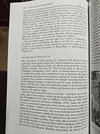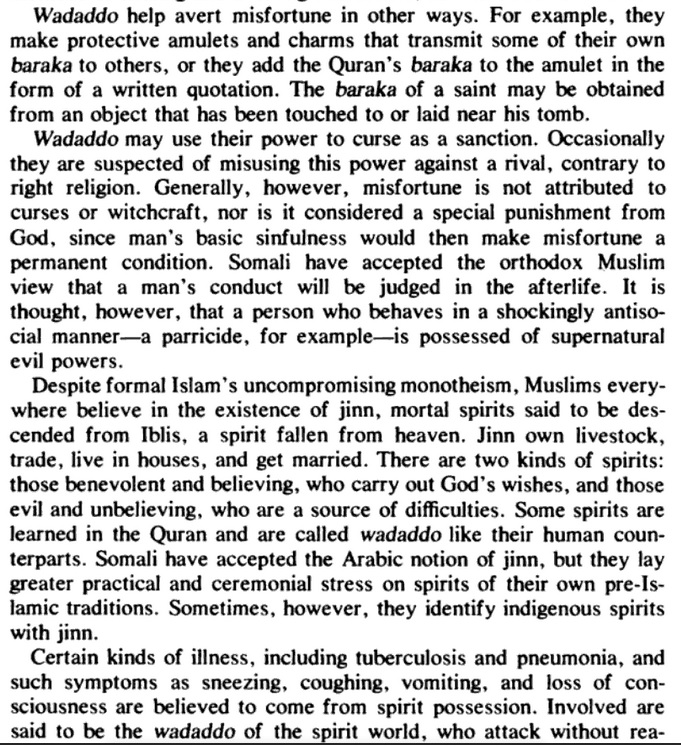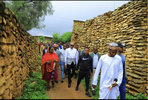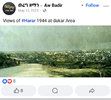You are using an out of date browser. It may not display this or other websites correctly.
You should upgrade or use an alternative browser.
You should upgrade or use an alternative browser.
Ancient somali ritual hunting
- Thread starter Midas
- Start date
Apparently we have somali idol deities. This so crazy that I've never heard anybody mentioning this.
You don't have permission to view the spoiler content.
Log in or register now.
Idilinaa
VIP
Apparently we have somali idol deities. This so crazy that I've never heard anybody mentioning this.
Because i don't think they were idols in the strict sense of the word, though related to related to middle eastern Ba'al. Baal in Somali context is used as just another for a monotheistic God . You can see this in the The Names of God in Nokthern Somali
Whereas Huuruse/Huur the ''Black Bird'' is actually a metaphor for a priest that acts an intermediary/messenger between humans and the Sky God Waaq:
The Black Crow Narrated by Professor Ahmed Mohammed Ali
"The crow was once a sheikh or priest, and at that time he was white. But all the other birds made an accusation against him.
They said, "On the one hand he eats meat, and on the other hand he eats fruits."
So all the birds came together and said, “You are a sheikh or a priest! But what you do is wrong. The smallest birds should eat meat. And the biggest ones eat fruit. But you eat from both sides.”
In not only Somali but Cushitic culture in general, it was said that the crow was the representative of the Sun God called Wak. Oromos believed in the Sun God also. People believed that the crow interpreted what Wak, the Sun God, said to the people and people would send their messages to the Sun God through him. The crow, when he speaks, says “Wak! Wak!”
But the crow became dishonest and ate from both things – fruit and meat, and so he was punished. They cursed him and he became black."
And Wadaad is also more like just a priest. Wad is actually bad spirits(Jiins) and not an idol, that a priest called Wad'aad excercizes/treats the inflicted to get rid of.
I mentioned a bit about it before in a different thread in relation to Somali folk medicine:
Likewise the term Wadaad , more correctly spelled Waddad, plural Waddado is linked to the same pagan religious cult more specifically with spirits called ''Wad'' in Somali culture and these spirits were associated with illness, curses and sickness
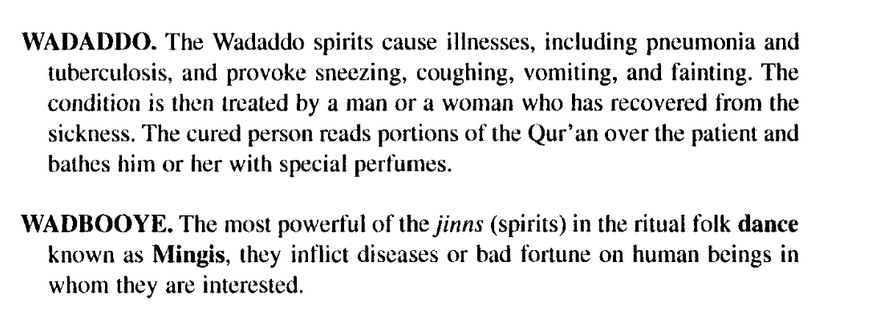
A Waddado was a nicknamer given to men/priests who's job was to give healing and medical treatment to cure various diseases and ailments.
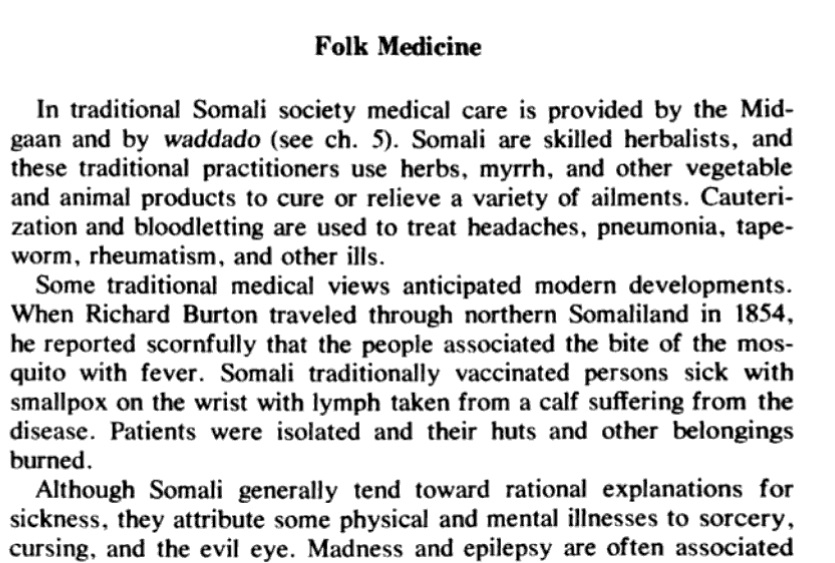
Whats interesting as well is that there is a hierarchy of Wad spirits as well. Like the one mention above called Wadbooye and you see this reflected in the northern Mingis (Spirit possession) rituals.
Other names we know like ''Ayaan'' which are good spirits that bring luck and good fortune.
In seeing this , it's not really surprising that Somalis had a seamless adoption of Abrahamic Faith, because much of their former beliefs closely aligned with it.
Last edited:
Interesting although I still think they're is something to the idea of shared afroasiatic deities (isrir (isis?) or concepts. I think the wadad think is probably more complicated since gala in his book somali weather folklore makes it clear that the people with astrological/astronomy knowledge are seprate from wadaads . It makes me wonder where these roles always separate and if not when did the division happen? To your point about the Abrahamic faith I wonder if somalis since they love to memorize texts if we had anicent preabrahmic relegious texts that we memorized maybe in the form of a poem?Because i don't think they were idols in the strict sense of the word, though related to related to middle eastern Ba'al. Baal in Somali context is used as just another for a monotheistic God . You can see this in the The Names of God in Nokthern Somali
Whereas Huuruse/Huur the ''Black Bird'' is actually a metaphor for a priest that acts an intermediary/messenger between humans and the Sky God Waaq:
The Black Crow Narrated by Professor Ahmed Mohammed Ali
And Wadaad is also more like just a priest. Wad is actually bad spirits(Jiins) and not an idol, that a priest called Wad'aad excercizes/treats the inflicted to get rid of.
I mentioned a bit about it before in a different thread in relation to Somali folk medicine:
Other names we know like ''Ayaan'' which are good spirits that bring luck and good fortune.
In seeing this , it's not really surprising that Somalis had a seamless adoption of Abrahamic Faith, because much of their former beliefs closely aligned with it.
Idilinaa
VIP
You can surmise from this that Somalis had deep cultural ties to North Africa (Egypt, Sudan) and Arabia and that shaped their belief system aside from the native(Horn) elements that worked in re-interpreting them to fit it's own context. So the names may be related but their application and variations differ.Interesting although I still think they're is something to the idea of shared afroasiatic deities (isrir (isis?) or concepts. I think the wadad think is probably more complicated since gala in his book somali weather folklore makes it clear that the people with astrological/astronomy knowledge are seprate from wadaads . It makes me wonder where these roles always separate and if not when did the division happen? To your point about the Abrahamic faith I wonder if somalis since they love to memorize texts if we had anicent preabrahmic relegious texts that we memorized maybe in the form of a poem?
In the book she provides archeological and cultural evidence for the presence of Christianity amongst Somalis. Chrisitian graves, traditions of crosses etc.
Just wanted to let you know there is an actual Aw Barkhadle shrine in the Harari plateau, Hararis used to make ziyara every Ramadan (I don’t remember specific night), and would just do dhikr of Allah there for the whole night. The Harari government spent some money recently to upkeep the deteriorating place.It's an interesting book for sure. Sade Mire is an archeologist who uses archeology to understand cultural heritage. Her main focus throughout the book is on the Aw Barkhadle shrine in Somaliland and uses it to propose the far-reaching impact of an archaeologically attested Eastern Cushitic ritual complex with an emphasis on fertility.


Somali style burial tombs near the Aw Barkhadle shrine.
Outside of this grand narrative, at it's core the book presents significant new material for example:
How the archeology of Aw Barkhadle fits within the medieval political landscape. It was a walled town whose remains features traces of a stone wall surrounding it , ruined houses, and couple of mosques and tombs. The old town in which the shrine is located is called ''Doggor'' or Dakkar which was the name of Awdal capital in the 15-16th century.


This connection is confirmed in the local chronicles from the 13th and 16th century.

How it relates to a synchronism of pasts practices, religions (christianity, pagan(waaq), islam) , pre-history, legends, rituals in one shared space.

Another interesting thing she points out elsewhere is how ''Awdal'' means ''The Land of Saints" in the Somali language. Aw(Saint) + Dal(Land) and how the walled town of Dakkar/Doggor was a pre-cursor to Harar. You prolly find this interesting @Shimbiris

Also a few kilometers away from Harar is literally a place called Dakar. You can literally search it up, not some “Doggor” Sada Mire pointed out.
Lastly, you should know the the founder of the Walasma dynasty’s name was Umar bin Dunya Hawaz. Dunya Hawaz literally means “a member of the material world.” This could refer to the fact that he was wealthy and powerful, hence part of this world material things.
Idilinaa
VIP
Just wanted to let you know there is an actual Aw Barkhadle shrine in the Harari plateau, Hararis used to make ziyara every Ramadan (I don’t remember specific night), and would just do dhikr of Allah there for the whole night. The Harari government spent some money recently to upkeep the deteriorating place.
Also a few kilometers away from Harar is literally a place called Dakar. You can literally search it up, not some “Doggor” Sada Mire pointed out.
Lastly, you should know the the founder of the Walasma dynasty’s name was Umar bin Dunya Hawaz. Dunya Hawaz literally means “a member of the material world.” This could refer to the fact that he was wealthy and powerful, hence part of this world material things.
There is no Awbarkhadle shrine or grave as far as i know in Harar, but there is the shrine of Sheikh Aw Abadir the patriarch of Aw Qutub Sheekhal clan and Emir Nur.
There is no other place called Dakkar, if you read the screenshots it was Paulitschke trying to locate the historic town mentioned in the chronicles , and came up with a theory that it was somewhere in Ogaden based on nothing really, but if you read the chronicle of Tarikh Al-Mujahiidin they place a resting place called Awbarkhadle in Dakkar , so Sada Mirre corrected him and said that the place is still known as Doggor near Hargeisa where the AwBarkhadle grave is located by the people that live near by and there is archeological remains that it was a large town that supports it. So it all adds up
The names of others leaders mentioned buried there as well.
Not in Harar, a few kilometers away. It’s like a mini village with the shrine. I attached a photo.There is no Awbarkhadle shrine or grave as far as i know in Harar, but there is the shrine of Sheikh Aw Abadir the patriarch of Aw Qutub Sheekhal clan and Emir Nur.
There is no other place called Dakkar, if you read the screenshots it was Paulitschke trying to locate the historic town mentioned in the chronicles , and came up with a theory that it was somewhere in Ogaden based on nothing really, but if you read the chronicle of Tarikh Al-Mujahiidin they place a resting place called Awbarkhadle in Dakkar , so Sada Mirre corrected him and said that the place is still known as Doggor near Hargeisa where the AwBarkhadle grave is located by the people that live near by and there is archeological remains that it was a large town that supports it. So it all adds up
Attachments
Idilinaa
VIP
Not in Harar, a few kilometers away. It’s like a mini village with the shrine. I attached a photo.
there is, go to Harar ask them where Dakar is and they’ll show u. It’s literally walking distance from Jugol. Beyond that town Dakar there are many ruins with old cities.
First i've ever heard of it. Find me a real source, i'm genuinely curious.
First i've ever heard of it. Find me a real source, i'm genuinely curious.
There is another paper regarding ruins near Dakar on the everythingharar.com database.
Attachments
Another interesting thing she ( Sade Mire ) points out elsewhere is how ''Awdal'' means ''The Land of Saints" in the Somali language. Aw(Saint) + Dal(Land) and how the walled town of Dakkar/Doggor was a pre-cursor to Harar.
Awdal does not mean " The Land of Saints " , I'm sorry to say that she ( Sade Mire ) and you are wrong .
I will soon write a new post to explain the true meaning of Dir and Darood .
I will soon write a new post to explain the true meaning of Dir and Darood .
Riftvalley
VIP
The lanqayr cross stuff is interesting because it would mean there was a deeper level of Christianity than we thought existed amongst ancient Somalis at least in the north west.
Idilinaa
VIP
Awdal does not mean " The Land of Saints " , I'm sorry to say that she ( Sade Mire ) and you are wrong .
I will soon write a new post to explain the true meaning of Dir and Darood .
Sada Mire did not come up with it ''The Land of Saints''. It's what local Somalis know it to mean, she is just communicating it in her piece.
The breaking it into Aw + Dal two compound words is my own deduction. Because it sounds pretty straight forward after she explained what the name means in Somali. In most likelihood it's linked to the Somali Saint cult i have spoken about in a different thread and it's why you see place names with ''Aw'' dotted all over the Somali inhabited areas from south to north to east to west.
KillStreakIsCool:
Aw is short for Awoowe, means grandfather. The female versions are Ay and Ayeeyo
Aw also means father and Ay means mother in Af-Maay and several other archaic Sam-Langauge and dialects. You can look up lexical data on them and that's what it shows.
Some interesting observation by researchers:
In fact, titles preceding names are perceived by most Somalis to be an affectation. Luling, in her studies of the more settled Geledi Somalis noted that they used the word 'Aw (literally, ''father'') for ''Mr'' and the word Ai (literally, ''mother'') for ''Mrs''...
In both the North and South they extend it as an addage to saints and religious figures to show respect because they become figurative mothers/fathers and are later held as ancestors.
So it's pretty much rooted in Somalis unique culture of ancestor veneration and respect for elders.
Last edited:
Idilinaa
VIP
There is another paper regarding ruins near Dakar on the everythingharar.com database.
A facebook post of an empty road? that's not very convincing. If it's real place it should be documented.
Sada Mire did not come up with it ''The Land of Saints''. It's what local Somalis know it to mean, she is just communicating it in her piece.
The breaking it into Aw + Dal two compound words is my own deduction. Because it sounds pretty straight forward after she explained what the name means in Somali. In most likelihood it's linked to the Somali Saint cult i have spoken about in a different thread and it's why you see place names with ''Aw'' dotted all over the Somali inhabited areas from south to north to east to west.
from Wikipedia :
Awdal ( أودل ) takes its name from the medieval Adal Sultanate ( Adal عَدَل ) , which was originally centered on Zeila.
Before we get into the meaning of “awdal”, do you agree with the above statement ?
Idilinaa
VIP
from Wikipedia :
Awdal ( أودل ) takes its name from the medieval Adal Sultanate ( Adal عَدَل ) , which was originally centered on Zeila.
Before we get into the meaning of “awdal”, do you agree with the above statement ?
Awdal/Adal is the name of a region/province around Zeyla and it's extending hinterland.
The name Awdal was recorded before the Sultanates establishment in the 15th century, so it cannot derive it's name from that

And in local sources it was not in reference to the 16th century sultanate but an actual region/province several centuries prior.

I agree with you that the name (Adal/Awdal) came before the establishment of the Islamic Sultanate of Adal .Awdal/Adal is the name of a region/province around Zeyla and it's extending hinterland.
The name Awdal was recorded before the Sultanates establishment in the 15th century, so it cannot derive it's name from that .
A question for you:
Do you think that the name (Adal) is derived from the name (awdal) or that the name (Awdal) is derived from the name (Adal)?
Idilinaa
VIP
I agree with you that the name (Adal/Awdal) came before the establishment of the Islamic Sultanate of Adal .
A question for you:
Do you think that the name (Adal) is derived from the name (awdal) or that the name (Awdal) is derived from the name (Adal)?
It was written in the spelling Awdal in the 13th century and in local sources, so yeah.
Adal and other variations like Adel/Aftal is actually a mistransliteration of the name. Hearing it first being said in the Somali speech/spelling and then others repeating it in their own language pronounciation afterwards.
Also wanted you to know there was an important sheikh in harar with the same name in 1890s called Haji Yusuf barkhadle, you sure it didn't belong to him? Considering I've never saw mention of this site earlier.Just wanted to let you know there is an actual Aw Barkhadle shrine in the Harari plateau, Hararis used to make ziyara every Ramadan (I don’t remember specific night), and would just do dhikr of Allah there for the whole night. The Harari government spent some money recently to upkeep the deteriorating place.
It's not something sada mire pointed out, locals preserved this history for centuries. Rishaashi who predated sada mire by alot also reported about the fact that aw barkhadle town is called "doggor".Also a few kilometers away from Harar is literally a place called Dakar. You can literally search it up, not some “Doggor” Sada Mire pointed out.
That's not true, it wasn't dunya hawaz (where you get that from?) But Dayna Xur/HurLastly, you should know the the founder of the Walasma dynasty’s name was Umar bin Dunya Hawaz. Dunya Hawaz literally means “a member of the material world.” This could refer to the fact that he was wealthy and powerful, hence part of this world material things.
Also share a proper photo of the allegad aw barkhadle shrine in harar.

